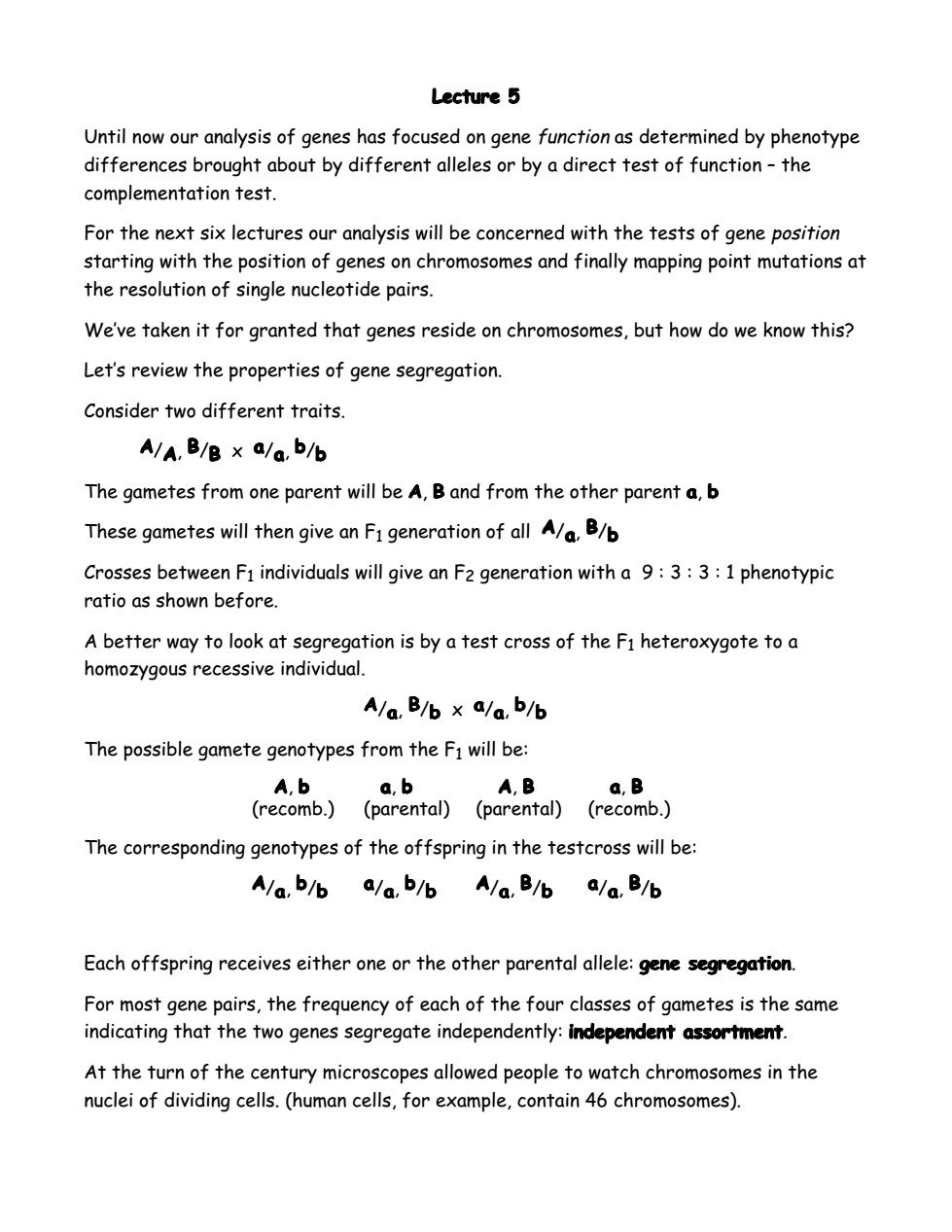正在加载图片...

Lecture 5 Until now our analysis of genes has focused on gene function as determined by phenotype differences brought about by different alleles or by a direct test of function-the complementation test. For the next six lectures our analysis will be concerned with the tests of gene position starting with the position of genes on chromosomes and finally mapping point mutations at the resolution of single nucleotide pairs We've taken it for granted that genes reside on chromosomes,but how do we know this? Let's review the properties of gene segregation. Consider two different traits. A/A.B/B x a/a,b/b The gametes from one parent will be A,B and from the other parent a,b These gametes will then give an F1 generation of all A/a.B/b Crosses between F1 individuals will give an F2 generation with a 9:3:3:1 phenotypic ratio as shown before. A better way to look at segregation is by a test cross of the F1 heteroxygote to a homozygous recessive individual. A/a,B/b x a/a,b/b The possible gamete genotypes from the Fi will be: A,b a,b A,B a,B (recomb.)(parental)(parental) (recomb.) The corresponding genotypes of the offspring in the testcross will be: A/a.b/b a/a,b/b A/a,B/b a/a,B/b Each offspring receives either one or the other parental allele:gene segregation. For most gene pairs,the frequency of each of the four classes of gametes is the same indicating that the two genes segregate independently:independent assortment. At the turn of the century microscopes allowed people to watch chromosomes in the nuclei of dividing cells.(human cells,for example,contain 46 chromosomes).Lecture 5 Lecture 5Lecture 5 Until now our analysis of genes has focused on gene function as determined by phenotype differences brought about by different alleles or by a direct test of function – the complementation test. For the next six lectures our analysis will be concerned with the tests of gene position starting with the position of genes on chromosomes and finally mapping point mutations at the resolution of single nucleotide pairs. We’ve taken it for granted that genes reside on chromosomes, but how do we know this? Let’s review the properties of gene segregation. Consider two different traits. A/A, B/B x a/a, b/b The gametes from one parent will be A, B and from the other parent a, b These gametes will then give an F1 generation of all A/a, B/b Crosses between F1 individuals will give an F2 generation with a 9 : 3 : 3 : 1 phenotypic ratio as shown before. A better way to look at segregation is by a test cross of the F1 heteroxygote to a homozygous recessive individual. A/a, B/b x a/a, b/b The possible gamete genotypes from the F1 will be: A, b a, b A, B a, B (recomb.) (parental) (parental) (recomb.) The corresponding genotypes of the offspring in the testcross will be: A/a, b/b a/a, b/b A/a, B/b a/a, B/b Each offspring receives either one or the other parental allele: gene segregation. For most gene pairs, the frequency of each of the four classes of gametes is the same indicating that the two genes segregate independently: independent assortment. At the turn of the century microscopes allowed people to watch chromosomes in the nuclei of dividing cells. (human cells, for example, contain 46 chromosomes)